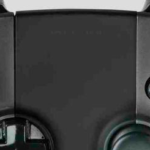
I would like to introduce you to the Ouya’s controller. When you get an Ouya, this is what you will spend much of your time holding in your hands as you play the increasing variety of great games available on the console. While I find this controller to be rather nice, it has some interesting characteristics that some might not be familiar with.
 While the layout of the buttons, directional pad and analog sticks is familiar to users of the XBox 360 and the Wii U’s Classic Controller, the introduction of the touch pad in the center is not something seen prior to its announcement. This feature is something that was touted by the Ouya team as another input game developers can take advantage of to bring better and more unique experiences to the gamer. Based on my experience, it seems to be rather responsive and not too sensitive. It works as it should. Unfortunately, not a lot of developers have taken advantage of its presence. Only one game I have played, Saturday Morning RPG, has tried to use it as part of the gameplay experience. I would certainly like to see more use of this in the future.
While the layout of the buttons, directional pad and analog sticks is familiar to users of the XBox 360 and the Wii U’s Classic Controller, the introduction of the touch pad in the center is not something seen prior to its announcement. This feature is something that was touted by the Ouya team as another input game developers can take advantage of to bring better and more unique experiences to the gamer. Based on my experience, it seems to be rather responsive and not too sensitive. It works as it should. Unfortunately, not a lot of developers have taken advantage of its presence. Only one game I have played, Saturday Morning RPG, has tried to use it as part of the gameplay experience. I would certainly like to see more use of this in the future.
The next feature is one that has become quite common in the last generation of consoles, the home button. Located below the touch pad and between the directional pad and right analog stick, this button doubles as a game input and your direct path back to the Ouya menu. While Ouya does allow developers to use this button as an in-game input, it still functions as the path back to the home menu. Tapping it twice in quick succession is how you get back home. This button is also how you will sync and turn on your controllers. Holding it down on an unsynced controller will light up the four LED lights near the top of the touch pad. When the two center lights are the only ones left flashing, the sync process has begun. Once synced, the LEDs will light up to indicate which player controller you have.











